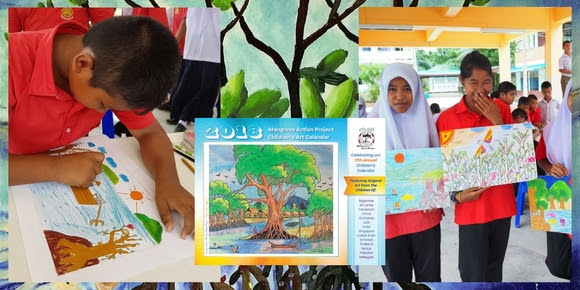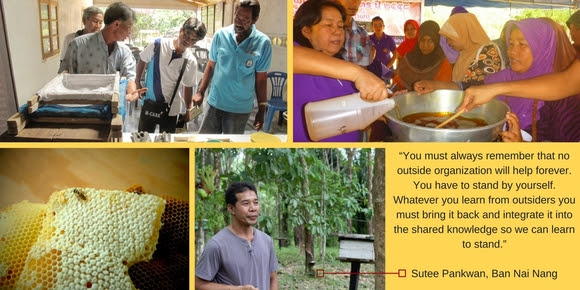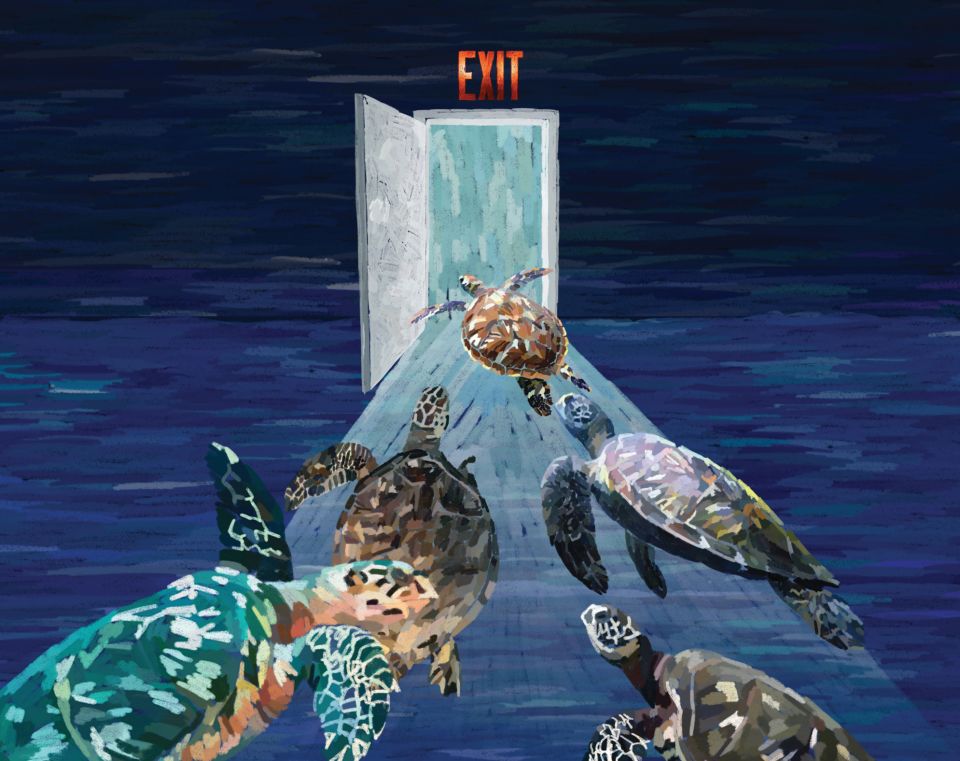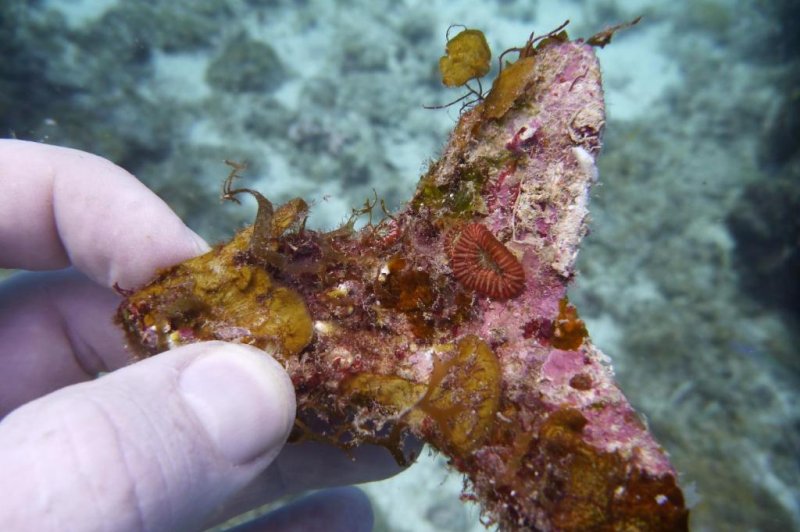|
The MAP News |
|
|
FEATURE STORY
Have you gotten your 2018 International Children’s Art Calendar yet?
 Our 17th edition, the 2018 calendar is our most beautiful to date, and celebrates MAP's 25th Anniversary! This colorful calendar has increased in popularity since its first publication in 2002. Children from 14 nations entered our contest by answering a simple, but intriguing question: “What do the mangroves mean to my community and myself?” The contest is paired with field trips and lessons, encouraging students to explore the mangroves. You can make an investment in the future of these children – every penny counts. Your contribution will help students become stewards of their precious coastal resources, and to pass their knowledge on to others. The calendar gives voice to the children who will become environmentalists, leaders, and mangrove conservationists. You can also purchase the calendar directly from our online store for $15*, or by sending a check to MAP at 606 Maynard Ave S Ste 102, Seattle, WA 98104.Will you help these children share how important mangroves are? ORDER NOW FREE WITH DONATION OF $35 OR MORE AFRICA Tanzania hastens plans for power plant in Selous game reserve TANZANIA - In June 2017, Tanzanian president John Pombe Magufuli rekindled plans to construct a huge hydropower plant in the Selous Game Reserve that he said will boost the country’s energy outlook. Conservationists are opposed to this project saying it threatens the endangered animal species in the area especially the black rhinoceros and elephants. “Over 200,000 people face a threat to their livelihoods downstream of the dam, in areas with high poverty where people rely on fish for their protein. Tanzania has to make wise and, informed choices about its development trajectory to ensure that these people will not suffer,” says Dr Amani Ngusaru, WWF Tanzania Country Director. According to WWF downstream changes to the Rufiji river flow and loss of sediment it carries could see the Rufiji Delta along with East Africa’s largest mangrove forest shrink, and the offshore fishery, reputedly Tanzania’s richest fishery, contract reveals the report. The 50,000 km2 Selous Game Reserve (SGR) is one of the most important protected areas in Africa, and has been recognized as a World Heritage Site since 1982. READ MORE Why Sierra Leone is running out of fish  SIERRA LEON - Foreign trawlers are plundering unguarded West African waters. One evening in Tombo, as fish buyers throng the seafront, an argument erupts at the far end of the harbour. Angry voices waft through the air, as Pa Seaport, the master fisherman of Sierra Leone, tries to solve a heated dispute between local fishermen and a South Korean man. They accuse him of damaging their nets with his trawler, which, they say, was heading to an area where fishing is banned. This squabble points to a much bigger problem. In Sierra Leone nearly half the population does not have enough to eat, and fish make up most of what little protein people get. But the country’s once-plentiful shoals, combined with its weak government, have lured a flotilla of unscrupulous foreign trawlers to its waters. Most of the trawlers fly Chinese flags, though dozens also sail from South Korea, Italy, Guinea and Russia. Their combined catch is pushing Sierra Leone’s fisheries to the brink of collapse. READ MORE ASIA Villages like Nai Nang and Ta Sanook need your partnership  Four years ago the community of Nai Nang in Thailand started producing honey made from the mangroves flowers surrounding the village. Nai Nang villagers had already been involved in apiculture for some time but MAP helped provide material, technical training, develop labels, marketing and equipment support to take this project to the next level. The hives were incredibly successful, and the community sells around 300 kilos of honey each year! The story doesn’t end there! A nearby village, Ta-Sanook, showed keen interest in beekeeping as an alternative livelihood. When members of each community met, it became evident that something exciting could begin here. Soon, villagers from Ta-Sanook undertook a day-long training under the supervision of the experienced leaders from Nai-Nang village. They demonstrated beekeeping techniques, shared beehive construction methods and gave important recommendations for producing honey. At a second training, the women of Nai Nang taught their sisters at Ta Sanook the craft of making value added products such as shampoo, conditioner and hand soap. Your $50 gift will get them the tools they need to successfully restore their mangroves. Chainsaws imperil an old-growth mangrove stronghold  MYANMAR - When viewed from the bow of a boat, the shoreline near the city of Myeik in southern Myanmar is all green. In every direction, low-slung mangroves blanket the horizon, their trunks submerged under several feet of water at high tide. The trees anchor a sprawling landscape that supports village life and a booming fishing industry up and down the shoreline of Tanintharyi, Myanmar’s southernmost state. But in many places, what appears green and lush from a distance disguises a landscape in peril. Christoph Zockler, an ornithologist with the German foundation Manfred-Hermsen-Stiftung for Nature Conservation and Environmental Protection, has seen this up close. He first traveled through this labyrinth of coastal islands and mudflats in 2013 in search of shorebirds. In November of 2016, in collaboration with the U.K.-based NGO Fauna and Flora International (FFI), Zockler and a team of researchers from Myeik launched a 12-day expedition of coastal Tanintharyi by boat, sleeping on board and, when the tides allowed, camping on shore. The team cataloged otters, dolphins, vast swarms of crabs at low tide, a wide variety of fish and more than 200 species of birds, including the critically endangered spoon-billed sandpiper (Calidris pygmaea), of which no more than 600 likely remain on Earth. But among the marine wildlife and endangered bird sightings, the team also observed human activity that is putting the future of the mangroves in jeopardy. READ MORE Industrial pollution ravaging Sg Chalok's once vibrant ecosystem  SINGAPORE - Sungai Chalok in Penarik used to be a national hotspot for shrimp (udang galah) anglers, as it allowed them to snag as many as five kilogrammes of the crustaceans within less than half a day. But four years ago, the shrimp started to disappear and today, anglers would be lucky to capture three shrimps after a day’s-worth of fishing. Even the popular baung catfish and ‘udang gantung’ (small shrimp) are now missing from fish traps. The problem began when one of the country’s largest shrimp farms, run by Blue Archipelago Sdn Bhd, started discharging sea water contaminated with chemicals into Sungai Chalok, which affected the ecosystem, especially the shrimps which are sensitive to pollution. Stopa Sulong, 66, said shrimps are a barometer of the health of a river system. READ MORE AMERICAS At age 16, A Maryland student is working with NASA on mangrove problem  USA - In spring 2016, Liza Goldberg asked scientists at NASA's Goddard Space Flight Center in Greenbelt, Md., if she could do research there. But there was a problem: She was 14, and the agency's internship program accepts students starting at 16. As luck would have it, two NASA satellite experts — David Lagomasino and Temilola Fatoyinbo — saw the request. Lagomasino and Fatoyinbo thought Goldberg could help them use satellite data to map mangroves — muddy, tangled-trunk forests that fringe the coastlines of dozens of tropical countries and as far north as St. Augustine, Fla. Mangroves are critical ecosystems: They store huge amounts of carbon and nurture fish and shrimp species that millions of people depend on for food. But much about them remains mysterious. Less than two years later, Goldberg has developed what might be the world's first satellite-based early warning system to determine where mangroves are threatened. The work incorporates data from four satellites on mangrove growth and loss, rainfall, agriculture, and urban growth. Green, yellow and red pixels on a Google Earth base map indicate threat levels ranging from low to high. READ MORE The turtle liberation in El Salvador  EL SALVADOR - The Mangrove Association and its allies in El Salvador are showing that conservation works best if it has grassroots organizing behind it. These infant turtles are lucky to be alive. They're olive ridleys, and, like the six other sea turtle species still alive on Earth, they face harrowing threats to their survival. From the destruction of their coastal habitat, climate change, and entanglement in marine debris, their numbers have declined by at least 30 percent in recent decades, and the International Union for Conservation of Nature declares them vulnerable to extinction on its Red List of Threatened Species. They face extra peril in El Salvador, where the consumption of turtle eggs is a long-time culinary tradition and people comb the beach collecting eggs to sell at market. In this part of the country, though, baby turtles have bodyguards. Isla Montecristo is just one of hundreds of small Salvadoran communities that rely on the mangrove forest and its riches for their survival. Without the trees and their enormous root systems, the ocean would wash the town and its turtle hatchery away READ MORE EUROPE New coral sowing method could inspire large-scale reef restoration  GERMANY - Researchers with the nonprofit SECORE International have developed a new technique for planting coral. The method could enable reef restoration efforts at larger scales. Currently, the process of replanting reefs is labor-intensive. Divers plant coral larvae or coral fragments individually. Often, such restoration efforts occur across a region no larger than 10,000 square feet. Meanwhile, coral degradation is occurring across thousands of square miles. The new technique involves the stabilization of coral larvae in a specially-designed substrate. Instead of being individually planted by hand, the larvae-lined substrate attaches naturally to the reef. The substrate looks like a small, star-like anchor. It is wedged into crevices in the reef, allowing the corals to naturally sows themselves into the reef structure. Using previous methods, the planting of 10,000 individual corals inside a 10,000 square-foot plot requires anywhere from several hundred to a few thousand person-hours of labor. "Sowing the same number of corals could be achieved in less than 50 person-hours, a time saving of over 90 percent," Margaret Miller, research director for SECORE, said in a news release. READ MORE OCEANA Ready the cocktail sauce: mega prawn farm gets go ahead for shrimp nursery  AUSTRALIA - Australia’s biggest producer of farmed prawns is set to become even bigger. Seafarms (ASX:SFG) this week got the tick of approval for its Sea Dragon shrimp project in the Northern Territory. Known for its operation of premium Crystal Bay prawns, the shrimp producer is developing a large-scale land-based project which aims to produce reliable volumes all year round, with potential to net the company in excess of $3 billion in export revenue. On Monday Seafarms was granted an aquaculture licence for its breeding and maturation centre near Darwin, where top quality prawns will roost before they move to the grow-out facility in East Kimberly. At full production Project Sea Dragon (PSD) will produce up to 150,000 tonnes a year of black tiger shrimp, in 10,000 hectares of production ponds. READ MORE Dear colleagues, The World Scientists’ Warning to Humanity has good momentum and is reaching millions of people. We are getting several thousand visitors a day on our Scientists’ Warning project website http://scientistswarning.forestry.oregonstate.edu/ In addition to English, the Warning is now available in 14 additional languages. These include Dutch, Simplified Chinese, Traditional Chinese, French, German, Hebrew, Hindi, Italian, Portuguese, Serbian, Spanish, Swedish, Telugu, and Turkish. These translations are available at http://scientistswarning.forestry.oregonstate.edu/ Any scientist that did not sign the article before the BioScience publication deadline, is invited to endorse it by visiting (scientists.forestry.oregonstate.edu). Please invite any of your scientist contacts to endorse the article. Your tweets have been very effective in keeping the momentum going, please continue this in the New Year with tweets such as: The #ScientistsWarningtoHumanity https://doi.org/10.1093/biosci/bix125 is now available in 14 new languages from several continents. View here: http://scientistswarning.forestry.oregonstate.edu/ or I signed the #ScientistsWarningtoHumanity and now all can show your support by sharing the following link: https://doi.org/10.1093/biosci/bix125 or I signed the #ScientistsWarningtoHumanity https://doi.org/10.1093/biosci/bix125 and other scientists can still help by endorsing the article here: http://scientistswarning.forestry.oregonstate.edu/ Thanks again for signing the article, William (Bill) J. Ripple, Distinguished Professor of Ecology, Oregon State University Ps. The concern for a liveable world has become a global movement as we can see with the nomination of three environmental pioneers for the Nobel Peace Prize. Check out this website NP4SD.org if you wish to endorse-nominate awarding the Nobel Peace Prize (themed for Sustainable Development) jointly to the Club of Rome, Dr. Herman Daly and Pope Francis. |
ACTION ALERTSRestore and Protect Wetlands and Mangroves in Chicxulub Port, Yucatán, México SIGN THE PETITION
|
Mangrove Action ProjectClick here to view past newsletters |
|
Search News Archive
Thursday, January 4, 2018
MAP News Issue 433 - Jan 6, 2018
Subscribe to:
Post Comments (Atom)
-
The community of adults and youth in Cayman Islands has come together recently to release a series of educational videos. Each is geared to...
-
By Alfredo Quarto, Program & Policy Director Co-founder, MAP There is a rather urgent situation concerning the bio-invasion of the Son...
-
By: Isabel Robinson, MAP Volunteer Intern Some months ago I decided to come to Thailand and do an internship in mangrove conservation, ...
MAP News Issue #595 - April 6, 2024
Push to restore Philippines' mangroves at risk from salt farm law PHILIPPINES - Along the flood-prone coasts of the Philippines, one o...










No comments:
Post a Comment
Note: Only a member of this blog may post a comment.